 John Lothropp was my 9th-great grandfather on the Crosby side. He was a pious man; a man of the cloth. Nonetheless, in 1632 he was sent to Hell by William Laud — the Bishop of London and later the infamous Archbishop of Canterbury — who 13 years later was himself beheaded.
John Lothropp was my 9th-great grandfather on the Crosby side. He was a pious man; a man of the cloth. Nonetheless, in 1632 he was sent to Hell by William Laud — the Bishop of London and later the infamous Archbishop of Canterbury — who 13 years later was himself beheaded.
— Protagonist
John Lothropp was born to Thomas and Mary (Howell) Lothropp in Etton, Yorkshire England and was baptized there 20 Dec 1584. He was the 4th of his father’s 22 children. His father was married three times and Mary Howell was his first wife. The Lothropps must have been fairly well off, because John attended Queens College in Cambridge, where he earned a Bachelor degree in 1605 and a Masters degree in 1609.
John was ordained as a minister of the Church of England and assigned to a church in Egerton, England. However, in 1623 John abandoned the church of England, having tired of the church’s role in politics and joined the Independent movement. As a leader of an Independent church, John risked arrest — the Church of England was the only church permitted to operate in England.
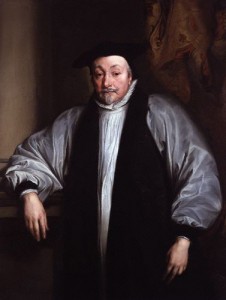
— Antagonist
William Laud was born 1573. The son of a cloth merchant, he graduated St. John’s College, Oxford. Laud was ordained in 1601 and quickly established a reputation for being intolerant of other religious views. King James I distrusted Laud and kept him from attaining prominence. However, with the death of James I in 1625, Charles I ascended the throne and he was a fan of Laud’s.
In 1628, Charles I appointed Laud to Bishop of London. During his reign Laud searched out and prosecuted/persecuted Puritans and other Independent church leaders and congregations. The Independent churches knew the risk and worshiped in secret.
John Lothropp and parishioners worshiped in secret for 8 years. All the while agents of the Bishop of London, William Laud (1628-33) were out searching for Lothropp and other nonconforming congregations in the Diocese of London. Agents of Laud arrested Lothropp and his congregation in 1632. Most parish members were imprisoned for eighteen months, but John Lothropp and the other elders were imprisoned for more than two years.
In 1633 William Laud was enthroned as the Archbishop of Canterbury and he quickly set about enforcing a doctrine of intolerance for other religions.
The pun “give great praise to the Lord, and little Laud to the devil” is a warning to King Charles attributed to the official court jester Archibald Armstrong. Laud was known to be touchy about his diminutive stature. ” — Trevor-Roper
Dreaded Newgate Prison
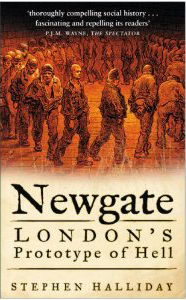
With his arrest, John Lothropp found himself in London’s Newgate Gaol (Jail). History records that if there ever was a Hell on Earth then Newgate was that place. Torture, executions and all manner of almost unthinkable depravity happened in Newgate. Worse yet, was that the method executions were almost held as an art form, or a sport! Newgate was where prisoners were beheaded and their heads were boiled in large vats in underground chambers and the poached remains were mounted on pikes and used to adorn the walls of the prison. More horrific than the efficiency of the executioners was the effect of disease. During Newgate’s 4-centuries of existence thousands of prisoners and guards died from disease — many more than were ever executed.
The Tower of London, although better known, pales in comparison to Newgate. In the 1600s a convicted politician complained that his status entitled him to be held at the Tower of London and not Newgate.
“In addition to male and female felons, who were generally kept in irons and whose numbers swelled before each meeting of the court, there were separate wards for male and female debtors, both master’s side (for those able to pay for their accommodation) and common side. As with most debtors’ prisons, the master’s side could be very comfortable, but the common side was hell.” London Lives
Prisoners who had the financial means could pay for everything from a blanket to sleep on, to a prostitute to sleep with. Everything in Newgate had a price and most prisoners had to pay the Gaoler before they would be released — Just because the court released a person did not mean that person could leave Newgate. Families not only had to pay to have the living released, but there was a fee to have the bodies released. The bodies of prisoners whose families could not afford the fee were simply left to rot where they died. The aroma of diseased prisoners, decaying corpses, poaching vats for heads and all the other manner of smells associated with a dungeon often wafted beyond the walls of Newgate an into the streets of London.
Conditional Release

In 1633 William Laud was enthroned as Archbishop of Canterbury. The new Bishop of London, William Juxon, granted John Lothropp’s release from Newgate in 1634. John was released on condition that he leave England and go to the New World (not known as New England yet).
During his stay in Newgate John’s wife, Hannah, became sick and died. Friends and parishioners tried to care for John’s eight children but eventually they were forced to live and beg on the streets of London. Despite all the loss that he suffered and the risk to his family and himself, John did not leave England. Instead, he remained and began preaching again. It wasn’t until he learned that he was once again a wanted man and being hunted for, that John finally left England for America.
The first Puritan church in Scituate (Plymouth Colony) was established by John and his followers in 1635. Lothropp later moved to Barnstable, MA and served as a minister until his death.
The bible that John brought to America was damaged during the voyage. Embers from a candle had burned some of the pages. John patched the pages together and wrote in the missing text. John’s bible survived the centuries and is now on display in the Sturgis Library in Barnstable, MA.
Epilogue — Heads Roll
William Laud was beheaded on January 10, 1645. On January 30, 1649 the man who elevated Laud to power, King Charles I, was also beheaded. John Lothropp outlived both; he died — with his head still attached — on November 8, 1653 in Barnstable, MA. A 1984 book estimated John Lothropp’s descendants in America to number more than 80,000.
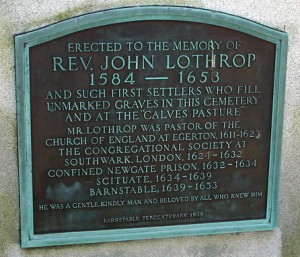 My Lineage from John Lothropp:
My Lineage from John Lothropp:
John Lothropp > Abigail (Lothropp) Clarke > Thomas Clarke > Anna (Clarke) Ellis >
Eleanor (Ellis*) Perry > Elisha Perry > Sarah (Perry) Landers > Eliza (Landers) Tinkham >
Sarah (Tinkham) Crosby > Roy Crosby > Maurice Crosby > Me
*Coincidence:
In 1638, John Lothropp wrote several letters to Thomas Prence, Governor of Plymouth Colony. Little did they know that, four generations later, two of their great-great grandchildren would marry; I am descended from that marriage. Eleanor Ellis* married Moses Perry — 10 Nov 1743 in Barnstable, MA.
Alternate Spellings of Lothropp: Lothrop, Lathrop
Sources:
- http://www.exlibris.org/nonconform/engdis/jacobites.html
- Encyclopedia Britannica http://www.britannica.com/EBchecked/topic/332198/William-Laud
- Newgate: London’s Prototype of Hell, Stephen Halliday, 2006
- Ancestors and Descendants of Daniel Lothrop St., 1545-1901; George David Read Hubbard, 1901
- A genealogical memoir of the Lo-Lathrop Family in This Country ; E.B. Huntington, 1884
- John Lothrop in Barnstable: A 370th Anniversary Tribute ; Lucy Loomis, Sturgis Library, 2011
- Exiled: The Story of John Lathrop 1585-1653; Helen Holt, 1987
- Archbishop Laud; Trevor-Roper, Hugh Phoenix Press reissue 2000 p.27

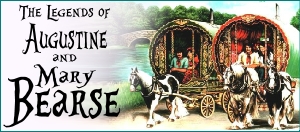
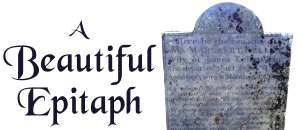
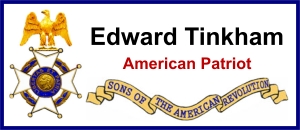
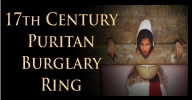

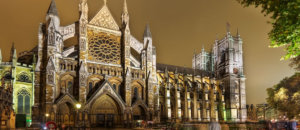
Wow! Having just found your blog, I must say I am very impressed. Thank you so much for sharing such a talented passion. I originally found it in a search regarding Yarmouth, Nova Scotia, and your link to Capt. Kelley came up.
Very similar to Capt. Kelley, my grandfather (x5) Capt. Joshua Pitman Trefry left Marblehead, MA is 1765 for Yarmouth Cty and settled on Chebogue Point which is next to Kelley Cove. I live five miles from Marblehead and 5 miles from Manchester, MA. I’ve actually taken photos of Kelley tombstones in Manchester, but none for the 1700’s. My gr-gr father and his wife lived in Kelley Cove until the Captain died at sea in 1865. I recently visited Kelley Cove, N.S. and took some beautiful photos. Plus the best scallops I have ever eaten were at the Windlass restaurant in Kelley Cove. Thanks again.
Paul. Thanks, I am glad you found the blog interesting. I checked the “Annals of Yarmouth and Barrington (Nova Scotia) in the Revolutionary War” by Edmund Poole (1899) and found mention of your great grandfather, Jushua Trefry. Pages 103-105 detail how he lent aid to the American cause during the American Revolution. His service, even as a Nova Scotian citizen, maked him eligible for entry into DAR and SAR (Daughters/Sons of the American Revolution).
Excellent post! I am also a 9th great-grandchild of John Lothrop/Lothropp’s.
John Lothrop Reverend (1584 – 1653) is your 9th great grandfather
Barnabas Lothrop , Judge (1636 – 1715) son of John Lothrop Reverend
Berusha Lothrop (1671 – 1742) daughter of Barnabas Lothrop , Judge
Samuel Lothrop Smith (1691 – 1768) son of Berusha Lothrop
Abigail Freeman Smith (1718 – 1793) daughter of Samuel Lothrop Smith
Jesse Eldredge (1742 – 1788) son of Abigail Freeman Smith
Elijah Eldredge (1778 – 1856) son of Jesse Eldredge
William Hunt Eldredge (1826 – 1889) son of Elijah Eldredge
Willard Holt Eldredge (1882 – 1957) son of William Hunt Eldredge
Lester Fremont Eldredge (1909 – 1991) son of Willard Holt Eldredge
Charles Sherwood Eldridge (1938 – 2013) son of Lester Fremont Eldredge (and my father)
My mother’s side is also tied to the early settlers. Isaac Allerton is my 11th gr. grandfather on my maternal side. As for Thomas Prence? Samuel Lothrop Smith (above) married Abigail Freeman, the great-granddaughter of Thomas Prence.
Thomas Prence Governor (1599 – 1673) is your 9th great grandfather
Mercy Prence (1631 – 1711) daughter of Thomas Prence Governor
Nathaniel Freeman (1669 – 1760) son of Mercy Prence
Abigail Freeman (1693 – 1737) daughter of Nathaniel Freeman
Abigail Freeman Smith (1718 – 1793) daughter of Abigail Freeman
Jesse Eldredge (1742 – 1788) son of Abigail Freeman Smith (etc, as in listing above)
Hello Cousin,
It looks like we are related along both of your parent’s lines. I am also descended from Thomas Prence.
Just fascinating. After inheriting my great-grandmother’s genealogy research and browsing articles, I see that I’m the 11th great-grandchild of the Rev. John Lathrop(p).
Thanks so much for sharing this story.
Rev. Lathrop – Thomas Lathrop – Melatiah Lathrop – Capt. Hope Lathrop – John lathrop – Hannah Lathrop – Hannah Fellows – Herman Waterman – Julia Waterman – Mary Isabelle Shaw – Lela McConnell – Lucien Trimble – Bob Trimble (dad) – Me